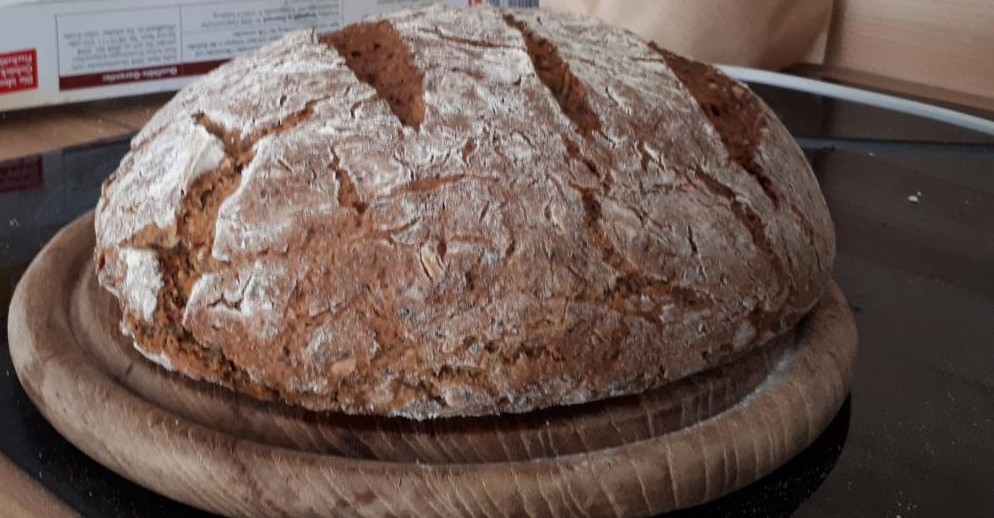So I made bread again. Followed this recipe: https://feastandfarm.com/easy-yeast-rolls/. Obviously I shaped the dough into bread not rolls. Used that recipe because it was one of the top results on Youtube for "how to make bread."
Bread turned out perfectly edible, but I believe I made the following errors. First, my house is way too cold. I haven't got a thermometer in the house but it wouldn't surprise me if the kitchen is 63°F. I saw a tip somewhere that said if you let your oven preheat to 350 for two minutes, then shut it off and put the dough in there it'll rise. This worked, took about two hours for it to not-quite double. I kneaded it, but I don't think I kneaded for long enough, never got to the window pane light dealy. Also kneaded on a floured surface, and might've added a little too much flour in the process. I see King Arthur recommends an oiled surface, I'll try that next time. Shaped it, put it in a 9x5 loaf pan. It never rose over the top of the pan. After an hour (rising in the oven like before) the crown had just reached the lip of the pan. I left it for another hour, and it had collapsed on itself. Maybe I disturbed it too much when I took it out of the oven the first time. Anyway, google has taught me that bread pans ought to be 8.5x4.5 (for the amount of flour I was using) so I am going to buy one of those in the near future.
Regardless it tastes great with a little butter or honey.
The less flour you have in the dough the easier and faster it rises, I usually add until it stops sticking to the bowl, but you can also achieve this with some tactical oil use. In bakeries the bread is put into a sauna-like environment for hour or two depending on how heavy it is, so leaving it to rise for 2-3 hours in a warm place isnt going to harm it. I've seen left-over dough rise in 8c (46,4f) temperatures while laying on a cold stone floor, it just takes time.
Anyway, lookin' real good :meow-melt:
Looks dope! Sometimes when my apt is cold I'll boil water in a pan then put it on the floor of my oven and let the yeast proof in there. I usually have to reheat the water once or twice but it helps the dough rise in colder days.
temperature matters, and humidity can make a difference too. also, how old the yeast is, and how much catalyst (e.g., sugar) you use.
Hell yeah, nicely done! In my experience bread is pretty random (temp, humidity, overall water content, etc), with it turning out a little different each time
I’d been trying out different loaves that rise in the pan like this, and eventually settled on King Arthur’s [https://www.kingarthurbaking.com/recipes/english-muffin-toasting-bread-recipe](English Muffin Bread} as the one that worked best for me personally. Unfortunately it does require sourdough starter (which you can make, it’s just annoying and takes a few days, and constant flour upkeep)
I guess part of my point is, some bread recipes are better than others, so if you can’t improve a loaf after a few tries, another recipe might simply work better. The one that made me switch to the King Arthur recipe, it also did weird stuff with the rise; a big bubble would form directly under the top of the loaf, and I could never figure out how to prevent that, and make sure it still had enough rise left when it went in to bake… stuff like that
but this one looks good, so no rush there!
A good solution to a cold kitchen is to do an overnight sponge - add your liquid and about 1/3 of the flour to a bowl with 1/2 - 1 tsp of yeast, cover, and let sit for 8-12 hours. Come back the next day, add your salt and butter/oil, then stir/knead in the rest of the flour. It starts out pretty sticky, but you can work it to your desired consistency without going over on flour.
The collapsing thing happens when you didn't knead enough or there's too little water in the mix.
If you want consistent results you must use a scale and weight how much water and flour you're putting into the mix, and never add any extra. Measuring by volume is not good enough because the volume of raw flour varies greatly depending on ambient humidity and how you take it out of the bag (with a spoon vs pouring, etc). This ratio is called "hydration". A typical hydration for bread is 65%, that is, 650 ml (650 g) of water in 1 kg (1000 g) of bread. Beyond 70% it's too difficult to knead by hand, and above 100% the "self-knead" time is about the same as the rising time.
Another thing less important to consistency is to have a controlled leavening environment. This might be unorthodox but I just let my dough rise in the fridge, in a bowl covered in plastic wrap . It takes an entire day but it always comes out the same.





